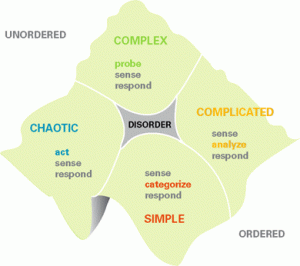The 5 Things That Will Save LinkedIn From Social Ruin
It’s surreal to have witnessed digital social networks being born — and more strange, their evolution.
Not long ago, I would have confidently said Facebook won the evolutionary race. It would be an easy claim to defend — then and now.
Facebook is still the largest social network, with over 2 billion users and growing.
Still, a few others — like the turbulent Twitter and the thunderous TikTok — could also compete in this race. And while many social media platforms continue to grow, most are missing one critical element: Etiquette.
Regardless of their intended use, most of the popular social networks have become mired in negativity and unwelcome and uncomfortable behavior. Some have even presented more serious mental health issues that result from their use.
One accomplished journalist boldly likened the fractured culture of social media to the biblical story and destruction of Babel — where an angered God brought into existence multiple languages, thus dividing people.
All the while, one popular network has widely avoided conspiracy theorists, the stream of negative commentary, and instead, actually helped its user base grow professionally.
LinkedIn. Standing head and shoulders above all the others in this regard is the popular professional network.
By the numbers, LinkedIn comes in at a healthy 810 million, albeit a far cry from Facebook’s 2 billion. Still, it’s the only network of significant size where the rules play out much like they do in real life.
I think it all has to do with unspoken etiquette — the same etiquette we see playing out in the wild when we encounter a person at a social event or standing in line at the grocery store. In a way, LinkedIn is at once old school and tremendously trendy.
Etiquette can be defined by how we behave in front of others. Good etiquette is akin to the gracious host making the guest the center of the world, and making everyone more at ease by following (often unspoken) social rules.
Inversely, bad etiquette causes unease — the kind of unease I feel posting anything moderately political on Twitter.
Here is where I think LinkedIn dominates and will continue to prevail.
The network lacks the sensationalism of Elon Musk and his 84 million Twitter followers, Mark Zuckerberg, and the latest dance craze — while it benefits from its professional-oriented content thoughtfully strung together with a community generally bent on being helpful.
So how do we keep this network productive — and honestly, comfortable to fully participate in?
I believe these simple guidelines will help you build your reputation and allow your network to flourish.
Guideline One: Come to Contribute
Perhaps the most important rule is to enter the space with the intention to contribute.
Figuring out your cadence might take some trial and error. That’s perfectly okay.
The point is not in the numbers — it’s in the participation. I engage in 5-10 posts a day (like and/or comment) and post found or original content roughly three times a week. That works for me.
It will likely be entirely different for you. Just find a way to contribute to the network. Like content, share it, find helpful information you think will help others.
Guideline Two: Share
In his amazing book, All I Really Needed to Know I Learned in Kindergarten, Robert Fulghum offers this advice: share everything. And what a guide it is for today’s social media-heavy world.
I recently received a note on LinkedIn from a local competitor asking whether I could advise them on a human resource need. One camp would advise keeping resources close, so they are there when I need them.
The other is to share as broadly and widely as possible, so all lights shine brightly. I will always choose the latter. For LinkedIn to be an excellent place, we need to find ways to share and prop each other up.
You see this behavior every day on LinkedIn.
Multiple CEOs go out of their way to share tips and tricks. Founders, sometimes struggling themselves, prop up their feel entrepreneurs. Job seekers share resources with others in the community. Sharing builds up everyone.
Guideline Three: Play in Your Lane
Potentially the most controversial piece of advice I will offer here is to play in your lane. It’s advice, not a directive. In building your reputation and participating in the community, I believe it’s helpful to focus on your core knowledge and interest areas.
I maintain five core areas — food/agriculture, environmentalism, communications/marketing, innovation/trends, and kindness/etiquette — that I generally follow, post about, share about and like posts about.
My intention is to build my community around those topics — so people following me have a good idea of the topics I personally post about.
And likewise, I benefit by staying on top of trending and thoughtful news about those areas of interest.
Guideline Four: Handshakes before Hugs
As a general rule, don’t hit “connect” unless you truly know the person — have their email, have met them. If you don’t know the person, but want to, take the time to get to know them in other ways before hitting connect.
LinkedIn has a “Follow” button that allows you to follow that individual’s content without connecting. This does not mean you can’t expand your network.
You can message people you are interested in engaging with. Taking this approach allows you to provide some background information on why you are reaching out. In my experience, this often prompts them to connect with you.
I generally save “connecting” until I’ve had at least a few interactions — some messages exchanged, a live call, an in-person meeting.
Guideline Five: Be Curious
For the most part, people are taking the time to post and comment because they find interest in what they are sharing. Be curious about it and learn more about the topic they are contributing to. Curiosity is what fuels the community.
Guideline Six: Ignore the bots
Occasionally the unhelpful will enter a feed you’re engaging with, even on LinkedIn. I call these “bots” as most of them/all of them have profiles that look pretty fake (and probably are).
Treat them as such — ignore them. If what they are saying is against a LinkedIn policy, flag it. Otherwise, simply move on.
Without careful monitoring and continued good etiquette, LinkedIn could easily fall into the same dilemma that has plagued other social networks.
In the first half of 2021, the network deleted more than 15 million fake accounts. Even so, it is inevitable that some negativity will appear.
Robert Fulghum, who was mentioned earlier, actually had a lot of great advice in that kindergarten-themed book. Perhaps my favorite of all, “no matter how old you are – when you go out into the world, it is best to hold hands and stick together.” This is the golden rule of community.
(24)





